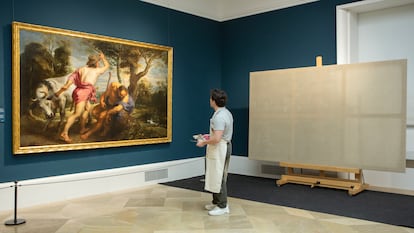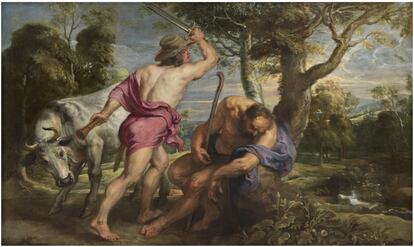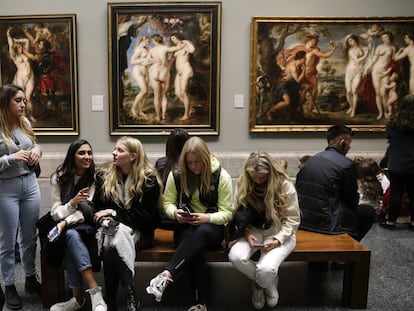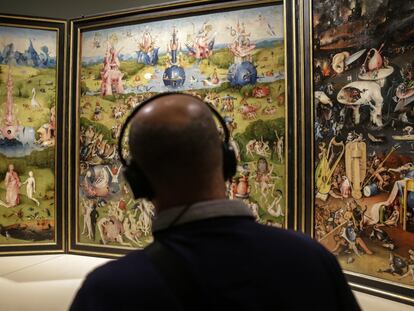The Prado Museum takes up the challenge of painting like Rubens
The esteemed Spanish gallery commissioned an artist to replicate a work by the baroque genius using the “Venetian technique,” which the Flemish painter developed to fulfill his many commissions on time


In the late sixteenth and early seventeenth centuries, with Europe experiencing a period of economic progress, bankers, merchants, kings and nobles began expanding and multiplying their palaces and other residences, which meant they needed to commission more and larger paintings to cover their spacious walls. In 1638, for example, Philip IV comissioned 120 works in a single order, from the painter Peter Paul Rubens (1577-1640). But no matter how hard the artist and his assistants worked, it was impossible for the German to meet that level of demand. In those days, a large painting might take an artist as much as six years to complete. And, as was the case with Velázquez, they might go for years without picking up a paintbrush at all, further postponing their promised dates of completion. It was for precisely this reason that the “Venetian technique” was first developed. This new method dramatically reduced the time it took to complete a painting: a work that might have taken five years to complete could be done in just one. No one knows who invented the method, though the Venetian Tiziano Vecelli (1490-1576; known in English as Titian) is rumored to be its pioneer, or at least one of the first to use it, and Rubens eventually learned and used it as well.
Next October, Madrid’s Prado Museum will inaugurate an exhibition entitled Rubens’ Workshop, curated by Alejandro Vergara Sharp (Washington D.C., 63), the institute’s Director of Conservation of Flemish Painting. The exhibit aims to recreate the artistic laboratory of the genius from Siegen, Germany in such intimate detail that even the smells of the studio will be reproduced. Of course, given the modern world’s health and safety regulations, the essence of toxic turpentine will be replaced by some other similar but innocuous scent. The exhibition will include some fifteen pieces — the Prado has more works by Rubens than any other museum in the world: 92 of his 1,500 total productions — and a detailed recreation, performed by a professional painter, of how the artist would have captured his imagination on canvas.
The Venetian technique, broadly speaking, consists of prioritizing color and its luminous sensations over the specific forms of a given painting. Prior to adopting the method, the Flemish, for example, would paint every detail millimeter by millimeter. The Venetian technique allowed them to use large swaths of color, starting with a dark background that highlighted the tonalities of the subsequent superimposed layers. From the 17th century on, practically until Goya, all painters adopted this method. “It’s what’s known as the economy of art,” Vergara explains. “An artist could finish many more paintings, which were a luxury product, and export them to other kingdoms where they were in demand. This meant that atists could earn a lot more money, because their works were larger and, therefore, more expensive.”

The artist chosen by the museum to recreate Rubens working in his studio is Jacobo Alcalde (Madrid, 33). When he was just nine years old, Alcalde was the recipient of an art scholarship, and by 19, one of his paintings was hanging in the European Museum of Modern Art (MEAM) in Barcelona. He spent years studying the Venetian technique. “Most of the painters of that era left written records describing how they worked, so we have a lot of documentation,” he says. “But the problem has been reading the Spanish texts from the 16th or 17th centuries and, above all, figuring out the measurements [the mixture ratios and percentages], because they didn’t indicate them. I also had to study textures, transparencies, saturations and color properties to try to recreate the works. The speed of the brushstroke is different when you’re using 17th versus 21st century paint.”
With the aforementioned technique, Alcalde will replicate Rubens’ Mercury and Argus, which is on display at the Prado. He says he will need at least five months to do it. He has already assembled the frame and stretched the canvas, which is the same size as the original. He has also sanded the surface with pumice to remove any imperfections in the canvas and primed it with a mixture of calcium carbonate, oil and earth. The mixture will take about two weeks to dry, and will be ready in early December.
Then, he will lightly outline the figures in the painting, begin to apply color primers, and start to paint the basic shapes. Finally, he will apply layers of semi-transparent color and then add the final highlights. The process ends with a full varnishing of the work.
The brushes and paints he will use are the same as those Rubens would have used, to accurately replicate the original textures and brushspeeds. The brushes are made with mustelid hair (hair from martens, badgers or squirrels) — materials that are no longer permitted. The lead white used by the painters of the era — an essential color in this period — was traditionally made by introducing several rolls of lead into a mixture of manure and wine vinegar. Everything was buried and, after a few weeks, would produce a layer of crusted flakes, which were then mixed with water and linseed and walnut oils until the desired texture was obtained. This type of paint, given the toxicity of lead, is also prohibited today.
The whole process will be videotaped by the Prado and played on large screens as part of the exhibition. “It’s a real challenge,” says Vergara. Alcalá adds: “I feel like an alchemist who doesn’t know what he’s going to end up creating.”
When Philip IV commissioned 120 pieces from Rubens, the artist replied that he could only deliver 60 on time, despite having 20 assistants at his disposal, including Anton van Dyck (1599-1641). In the end, the German painter only signed 14. Jacobo Alcalde only has to make one, but without his own workshop or assistants, and without a master to guide him. Fullfilling the Prado’s commission on time will be a real challenge. Just as it was for Rubens.
Sign up for our weekly newsletter to get more English-language news coverage from EL PAÍS USA Edition
Tu suscripción se está usando en otro dispositivo
¿Quieres añadir otro usuario a tu suscripción?
Si continúas leyendo en este dispositivo, no se podrá leer en el otro.
FlechaTu suscripción se está usando en otro dispositivo y solo puedes acceder a EL PAÍS desde un dispositivo a la vez.
Si quieres compartir tu cuenta, cambia tu suscripción a la modalidad Premium, así podrás añadir otro usuario. Cada uno accederá con su propia cuenta de email, lo que os permitirá personalizar vuestra experiencia en EL PAÍS.
¿Tienes una suscripción de empresa? Accede aquí para contratar más cuentas.
En el caso de no saber quién está usando tu cuenta, te recomendamos cambiar tu contraseña aquí.
Si decides continuar compartiendo tu cuenta, este mensaje se mostrará en tu dispositivo y en el de la otra persona que está usando tu cuenta de forma indefinida, afectando a tu experiencia de lectura. Puedes consultar aquí los términos y condiciones de la suscripción digital.
More information
Últimas noticias
Welcome to the post-religion era: The idea of Christianity as the absolute truth has become obsolete
‘I thought you would like it’: The risky sexual practice popularized by TV shows and TikTok
The digitalization of tourism: ‘They promise experiences and gave us the worst possible one’
Mexican peso defies uncertainty with forecasts of a new period of stability in 2026
Most viewed
- Sinaloa Cartel war is taking its toll on Los Chapitos
- Oona Chaplin: ‘I told James Cameron that I was living in a treehouse and starting a permaculture project with a friend’
- Reinhard Genzel, Nobel laureate in physics: ‘One-minute videos will never give you the truth’
- Why the price of coffee has skyrocketed: from Brazilian plantations to specialty coffee houses
- Silver prices are going crazy: This is what’s fueling the rally










































